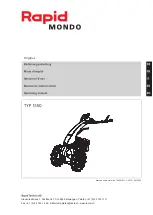
Safety instructions
4
Do not centrifuge toxic or radioactive substances or
pathogenic microorganisms without suitable safety
systems.
If microbiological samples of risk group II (according
to “Laboratory Bio-safety Manual” of WHO) are be-
ing centrifuged, aerosol-tight bio-seals have to be
used.
For materials in a higher risk group, more than one
precaution is required.
Should toxins or pathogenic substances enter the
centrifuge or its parts, you must perform appropriate
procedures for disinfection (see “Maintenance and
care – Disinfection”).
Strongly corrosive substances that may cause dam-
age to materials and reduce the mechanical
strength of the rotor may be centrifuged only inside
protective tubes.
Handling the centrifuge
Use only original accessories for the centrifuge. The
only exceptions are common glass or plastic centri-
fuge tubes if they are approved for the rotor speed
and RCF values.
Never use the centrifuge unless the rotor is properly
installed.
You may use the centrifuge only with a properly
loaded rotor. You must not overload the rotor.
Strictly follow the rules and regulations for cleaning
and disinfection
If the rotor or the rotor lid shows signs of corrosion
or wear, you must stop using it.
Never open the lid manually if the rotor is still turn-
ing.
You may use the emergency lid release only in case
of emergency, e.g. during an interruption of power
supply
(see chapter “Troubleshooting”).
Never use the centrifuge with an opened lid.
Never use the centrifuge if the front panel has been
partially or totally removed.
Changes in mechanical or electrical components of
the centrifuge may only be carried out by individuals
authorized by Thermo
Fisher Scientific
.
Содержание Cryofuge 5500i GMP
Страница 16: ...Description of the Cryofuge 12 Notes ...
Страница 20: ...Before the use 16 Notes ...
Страница 70: ...Maintenance and care 66 ...
Страница 99: ...Appendix 95 ...
Страница 107: ...Appendix 103 ...
Страница 113: ......









































